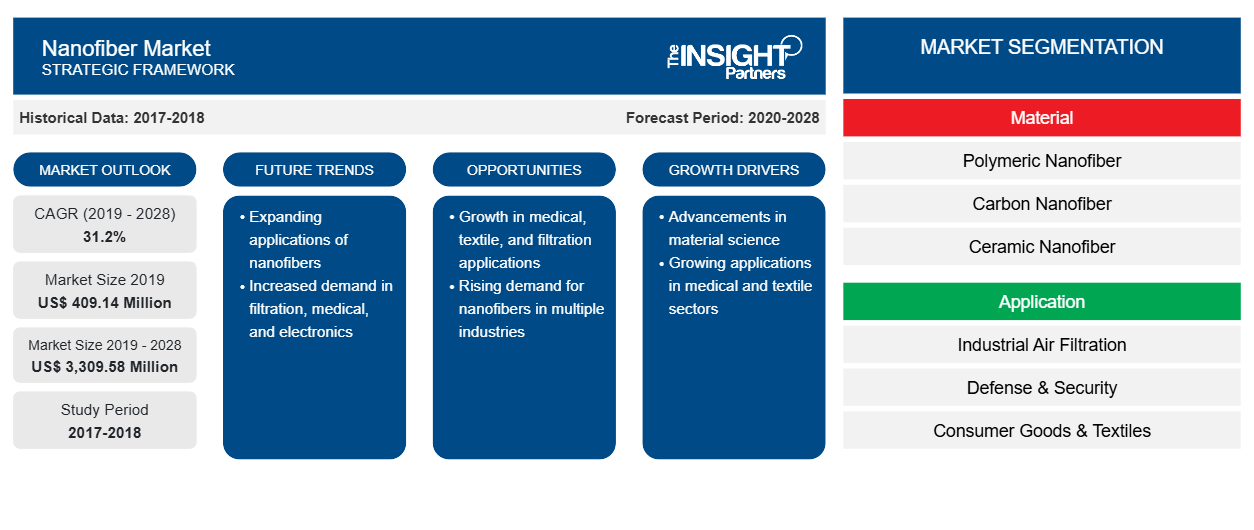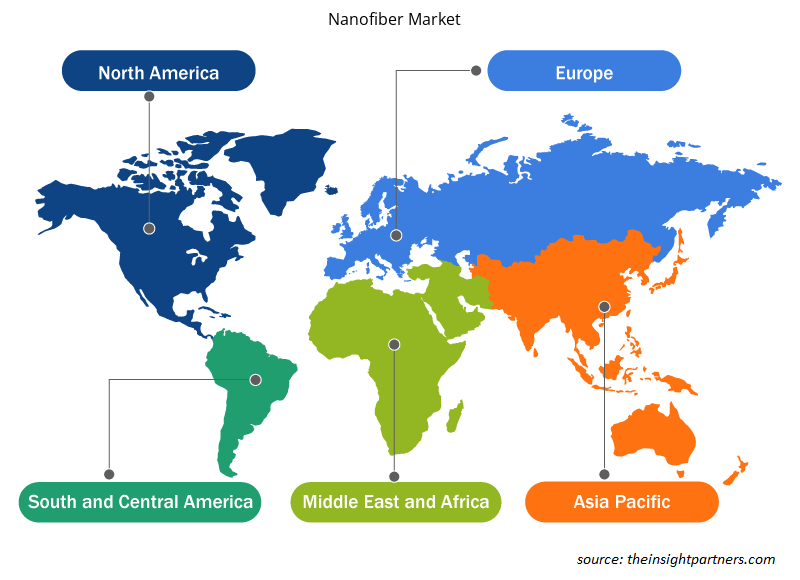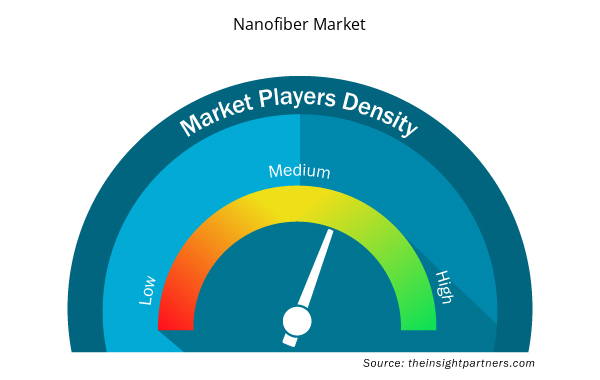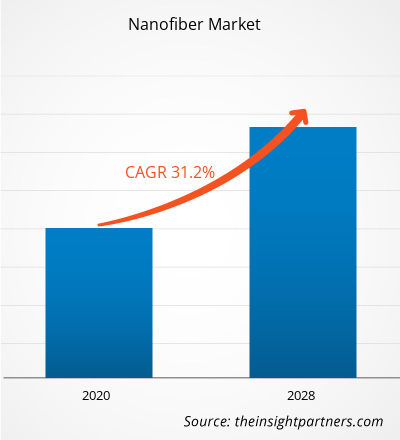The nanofiber market was valued at US$ 409.14 million in 2019 and is projected to reach US$ 3,309.58 million by 2028; it is expected to grow at a CAGR of 31.2% from 2020 to 2028.
Nanofiber is a fiber with a diameter less than 1 µm. These fibers help boost filtration efficiency with a relatively slight decrease in permeability. Rapid pace of industrialization, growing commercialization of nanofiber products with increasing industrial applications, continuous efforts in technological innovations, and rise in R&D investments are among the significant factors contributing to the nanofiber market growth.
In 2019, Asia Pacific was the largest market for nanofibers. APAC is home to many developing countries that are witnessing high growth in their manufacturing sector; the region has become a global manufacturing hub. Among China’s evolution into a high-skilled manufacturing hub, other developing countries such as India, South Korea, Taiwan, and Vietnam are attracting several businesses that are in quest to relocate their low- to medium-skilled manufacturing facilities to neighboring countries having lower labor cost. The governments of these countries are also welcoming such businesses by improving investment ideas or by encouraging foreign direct investments (FDIs).
The COVID-19 has been adversely affecting economies and industries in various countries due to government-imposed lockdowns, travel bans, and business shutdowns. The chemical & materials is one of the major industries suffering serious disruptions in the form of supply chain breaks, technology events cancellations, and office shutdowns. The shutdown of various plants and factories in North America, Europe, Asia Pacific, South America, and the Middle East and Africa has restricted the global supply chain and disturbed the manufacturing activities, delivery schedules, and product sales. Furthermore, various companies have already predicted possible delays in product deliveries and slump in future sales of their products. The travel bans imposed by countries in Europe, Asia, and North America are hindering the business collaborations and partnerships opportunities. In addition to these restrictions, limited availability of working professionals and lowered production levels due to social distancing measures are the factors hampering the activities in the chemical & materials industry, as well as various markets related to it. Many countries are now resuming to normalcy, whereas many are experiencing second wave of the outbreak. In addition, due to vaccination drives, the situation is likely to change in the coming months.
Customize This Report To Suit Your Requirement
You will get customization on any report - free of charge - including parts of this report, or country-level analysis, Excel Data pack, as well as avail great offers and discounts for start-ups & universities
Nanofiber Market: Strategic Insights

- Get Top Key Market Trends of this report.This FREE sample will include data analysis, ranging from market trends to estimates and forecasts.
Customize This Report To Suit Your Requirement
You will get customization on any report - free of charge - including parts of this report, or country-level analysis, Excel Data pack, as well as avail great offers and discounts for start-ups & universities
Nanofiber Market: Strategic Insights

- Get Top Key Market Trends of this report.This FREE sample will include data analysis, ranging from market trends to estimates and forecasts.
Market Insights
Rapid Pace of Industrialization and Need to Reduce Harmful Emissions from Industrial Plants
The global manufacturing sector is rapidly expanding as more and newer regions are investing in the adoption of manufacturing plants in their localities. As per the China Federation of Logistics and Purchasing (CFLP), the purchasing managers index (PMI) of the global manufacturing sector was 55.1 in October 2017, while it was 55.9 in September 2017; however, the index is overall at its peak in these months. The PMI index was ~53.5 since the beginning of 2017, signifying a sturdy recovery of the manufacturing sector in developed countries, increasing industrial advancements in emerging economies, and intensifying commodities prices in the global market. The proliferating manufacturing sector is expected to embrace technological advancements to gain competitive advantage by enhancing plant productivity as well as by keeping updates regarding the changes in customer preferences. The manufacturing sector is presently in the middle of a technological renaissance, which is changing the outlook and processes of the modern factory. However, the magnification of operations of various industries is also contributing to the environmental hazards, especially in the heavily industrialized cities. Heavy industrialization is also affecting the health of the population residing in proximity to these businesses through toxic emissions.
Material Insights
Based on material, the nanofiber market is segmented into polymeric nanofiber, carbon nanofiber, ceramic nanofiber, glass nanofiber, and others. The carbon nanofiber segment led the nanofiber market with the largest share in 2020. Carbon Nanofibers are made by the elimination of non-carbon elements from the synthetic polymers and biopolymers at extremely high temperatures. In the floating catalyst method of carbon nanofiber manufacturing, various metals in the powdered or support forms are used as catalytic entities. Foils, gauzes, and wires, etc., are other catalysts used in the production of nanofibers. Carbon nanofibers exhibit high discontinuity and compatibility, among other physical properties, and are also highly graphitic. They have excellent mechanical properties with high electrical and thermal conductivity. The application areas for carbon Nanofibers include thermoplastics, elastomers, thermosets, ceramics, elastomers, and metals. Also, owing to their high tensile strength, and thermal and electrical conductivity, carbon nanofibers are also widely used in orthopedic, dental, and tissue engineering scaffolds.
Application Insights
Based on application, the nanofiber market is segmented into industrial air filtration, defense & security, consumer goods & textiles, electronic components, power & energy, healthcare & life sciences, chemical & environment, and others. The healthcare & life sciences segment led the market with the largest share in 2020. Biodegradable materials used in nanofiber are most suitable for the medical and healthcare industries. Further, the integration of additives allows multifunctionality of these nanofibers. As their structure and size can be controlled, they can be used in tissue engineering. A few of the major applications of nanofibers in life sciences and pharmaceuticals industries include drug deliver, wound healing, tissue engineering, and barrier textiles.
Key players in the nanofiber market include Ahlstrom-Munksjo; Asahi Kasei Corporation; Donaldson Company, Inc.; DuPont; Nanofibers Solution LLC, Inc.; Toray Industries, Inc.; Espin Technologies; Elmarco S.R.O.; Mempro Ltd.; and Revolution Fibers Ltd. The major companies in the market are focused on strategies such as mergers and acquisitions, and product launches to broaden their geographic presence and consumer base. For instance, in 2018, Donaldson introduced innovative system to make gas turbine filter selection easier for the operators to select replacement air filters, developing laboratory tests to quantify pulse recovery rate and water tightness.
Report Spotlights
- Progressive industry trends in the global nanofiber market to help players develop effective long-term strategies
- Business growth strategies adopted by companies operating in developed and developing markets
- Quantitative analysis of the global nanofiber market from 2017 to 2027
- Estimation of demand for nanofibers across various industries
- PEST analysis to illustrate the efficacy of buyers and suppliers operating in the industry to predict market growth
- Recent developments to understand the competitive market scenario and nanofiber demand
- Market trends and outlook coupled with factors driving and restraining the growth of the Nanofiber market
- Enlightening strategies that underpin commercial interest about global nanofiber market growth, to facilitate decision-making process
- Nanofiber market size at various nodes of market
- Detailed overview and segmentation of the nanofiber market, along with the industry dynamics
- Nanofiber market size in various regions with promising growth opportunities
Nanofiber Market Regional Insights
The regional trends and factors influencing the Nanofiber Market throughout the forecast period have been thoroughly explained by the analysts at Insight Partners. This section also discusses Nanofiber Market segments and geography across North America, Europe, Asia Pacific, Middle East and Africa, and South and Central America.

- Get the Regional Specific Data for Nanofiber Market
Nanofiber Market Report Scope
| Report Attribute | Details |
|---|---|
| Market size in 2019 | US$ 409.14 Million |
| Market Size by 2028 | US$ 3,309.58 Million |
| Global CAGR (2019 - 2028) | 31.2% |
| Historical Data | 2017-2018 |
| Forecast period | 2020-2028 |
| Segments Covered |
By Material
|
| Regions and Countries Covered | North America
|
| Market leaders and key company profiles |
Nanofiber Market Players Density: Understanding Its Impact on Business Dynamics
The Nanofiber Market market is growing rapidly, driven by increasing end-user demand due to factors such as evolving consumer preferences, technological advancements, and greater awareness of the product's benefits. As demand rises, businesses are expanding their offerings, innovating to meet consumer needs, and capitalizing on emerging trends, which further fuels market growth.
Market players density refers to the distribution of firms or companies operating within a particular market or industry. It indicates how many competitors (market players) are present in a given market space relative to its size or total market value.
Major Companies operating in the Nanofiber Market are:
- Ahlstrom-Munksjo
- Asahi Kasei Corporation
- Donaldson Company, Inc
- DuPont
- Nanofibers Solution LLC, Inc.
Disclaimer: The companies listed above are not ranked in any particular order.

- Get the Nanofiber Market top key players overview
Nanofiber Market, by Material
- Polymeric Nanofiber
- Carbon Nanofiber
- Ceramic Nanofiber
- Glass Nanofiber
- Others
Nanofiber Market – By Application
- Industrial Air Filtration
- Consumer Goods & Textiles
- Electronic Components
- Defense & Security
- Power & Energy
- Healthcare & Life Sciences
- Chemicals & Environment
- Others
Company Profiles
- Ahlstrom-Munksjo,
- Asahi Kasei Corporation
- Donaldson Company, Inc.
- DuPont
- Nanofibers Solution LLC, Inc.
- Toray Industries, Inc.
- Espin Technologie
- Elmarco S.R.O.
- Mempro Ltd.
- Revolution Fibers Ltd.
- Historical Analysis (2 Years), Base Year, Forecast (7 Years) with CAGR
- PEST and SWOT Analysis
- Market Size Value / Volume - Global, Regional, Country
- Industry and Competitive Landscape
- Excel Dataset


- Diaper Packaging Machine Market
- Artwork Management Software Market
- Non-Emergency Medical Transportation Market
- Smart Mining Market
- Environmental Consulting Service Market
- Point of Care Diagnostics Market
- Adaptive Traffic Control System Market
- Single Pair Ethernet Market
- Hair Wig Market
- Print Management Software Market

Report Coverage
Revenue forecast, Company Analysis, Industry landscape, Growth factors, and Trends

Segment Covered
Material and Application

Regional Scope
North America, Europe, Asia Pacific, Middle East & Africa, South & Central America

Country Scope
Australia, Brazil, Canada, China, France, Germany, India, Italy, Japan, Mexico, ROE, Saudi Arabia, South Africa, Spain, United Arab Emirates, United Kingdom, United States
Frequently Asked Questions
Polymeric nanofibers are generated from naturally or artificially synthesized polymers. Natural polymers include collagen, silk fibroin, cellulose, gelatin, chitosan and polysaccharides. While synthetic polymers include nylon, polyacrylonitrile, polystyrene, polycarbonate, Polyethylene terephthalate (PET), and water-soluble polymers. These fibers possess high specific area, excellent porosity and better flexibility in surface functionalities. They find enormous applications in various domains such as filtration, material reinforcements, energy storage, sensor devices and others. The growing demand from energy, water, chemicals, pharmaceutical, biotechnology, and food & beverage industries are expected to drive the market for polymer nanofibers across the globe. Apart from this, they are utilized in bone tissue engineering applications in the medical sector which further fueling the demand for polymer nanofiber globally.
The major players operating in the global nanofiber market are Ahlstrom-Munksjo, Asahi Kasei Corporation, Donaldson Company, Inc., DuPont, Nanofibers Solution LLC, Inc., Toray Industries, Inc., Espin Technologies, Elmarco S.R.O., Mempro Ltd., and Revolution Fibers Ltd.
In 2019, Asia Pacific contributed to the largest share in the global nanofiber market. The improving infrastructure, rising domestic consumption and lower costs are some of the factors attracting manufacturing companies in these countries. The development of manufacturing hub creates the demand for nanofibers to be used for a diverse range of purposes. Several governments have taken initiatives such as Made in China 2025, and Make in India, among others to propel the growth of manufacturing sector which further supports the growth of nanofibers market.
Trends and growth analysis reports related to Chemicals and Materials : READ MORE..
The List of Companies - Global Nanofiber Market
- Ahlstrom-Munksjo
- Asahi Kasei Corporation
- Donaldson Company, Inc
- DuPont
- Nanofibers Solution LLC, Inc.
- Toray Industries, Inc
- Espin Technologies
- Elmarco S.R.O.
- Mempro Ltd.
- Revolution Fibers Ltd.

 Get Free Sample For
Get Free Sample For